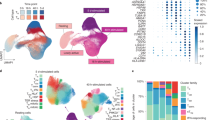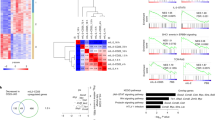Abstract
Modulation of many signaling pathways in antigen-stimulated T and B cells results in global changes in gene expression. Here we investigate the contribution of calcium signaling to gene expression in T cells using cell lines from two severe-combined immunodeficiency patients with several cytokine deficiencies and diminished activation of the transcription factor NFAT nuclear factor of activated T cells. These T cells show a strong defect in transmembrane calcium influx that is also apparent in their B cells and fibroblasts. DNA microarray analysis of calcium entry–deficient and control T cells shows that Ca2+ signals both activate and repress gene expression and are largely transduced through the phosphatase calcineurin. We demonstrate an elaborate network of signaling pathways downstream of the T cell receptor, explaining the complexity of changes in gene expression during T cell activation.
This is a preview of subscription content, access via your institution
Access options
Subscribe to this journal
Receive 12 print issues and online access
$209.00 per year
only $17.42 per issue
Buy this article
- Purchase on Springer Link
- Instant access to full article PDF
Prices may be subject to local taxes which are calculated during checkout







Similar content being viewed by others
Change history
06 February 2008
In the version of the article initially published, many errors and inappropriate manipulations were made in Figures 1, 3 and 5 (see PDF for details).
References
van Leeuwen, J. E. & Samelson, L. E. T cell antigen-receptor signal transduction. Curr. Opin. Immunol. 11, 242–248 (1999).
Braun, J., Sha'afi, R. I. & Unanue, E. R. Crosslinking by ligands to surface immunoglobulin triggers mobilization of intracellular 45Ca2+ in B lymphocytes. J. Cell Biol. 82, 755–766 (1979).
Hoth, M. & Penner, R. Depletion of intracellular calcium stores activates a calcium current in mast cells. Nature 355, 353–356 (1992).
Turner, H. & Kinet, J. P. Signalling through the high-affinity IgE receptor Fc epsilonRI. Nature 402, 24–30 (1999).
Dolmetsch, R. E., Lewis, R. S., Goodnow, C. C. & Healy, J. I. Differential activation of transcription factors induced by Ca2+ response amplitude and duration. Nature 386, 855–858 (1997).
Teague, T. K. et al. Activation changes the spectrum but not the diversity of genes expressed by T cells. Proc. Natl Acad. Sci. USA 96, 12691–12696 (1999).
Berridge, M. J. Inositol trisphosphate and calcium signalling. Nature 361, 315–325 (1993).
Putney, J. W., Jr. A model for receptor-regulated calcium entry. Cell Calcium 7, 1–12 (1986).
Clapham, D. E. Intracellular calcium. Replenishing the stores. Nature 375, 634–635 (1995).
Parekh, A. B. & Penner, R. Store depletion and calcium influx. Physiol. Rev. 77, 901–930 (1997).
Putney, J. W. & Ribeiro, C. M. P. Signaling pathways between the plasma membrane and endoplasmic reticulum calcium stores. Cell Mol. Life Sci. 57, 1272–1286 (2000).
Putney, J. W. “Kissin' cousins”: intimate plasma membrane-ER interactions underlie capacitative calcium entry. Cell 99, 5–8 (1999).
Okamura, H. & Rao, A. Transcriptional regulation in lymphocytes. Curr. Opin. Cell. Biol., in press (2001).
Crabtree, G. R. Generic signals and specific outcomes: signaling through Ca2+, calcineurin, and NF-AT. Cell 96, 611–614 (1999).
Kiani, A., Rao, A. & Aramburu, J. Manipulating immune responses with immunosuppressive agents that target NFAT. Immunity 12, 359–372 (2000).
Timmerman, L. A., Clipstone, N. A., Ho, S. N., Northrop, J. P. & Crabtree, G. R. Rapid shuttling of NF-AT in discrimination of Ca2+ signals and immunosuppression. Nature 383, 837–840 (1996).
Loh, C. et al. Calcineurin binds the transcription factor NFAT1 and reversibly regulates its activity. J. Biol. Chem. 271, 10884–10891 (1996).
Dolmetsch, R. E., Xu, K. & Lewis, R. S. Calcium oscillations increase the efficiency and specificity of gene expression. Nature 392, 933–936 (1998).
Li, W., Llopis, J., Whitney, M., Zlokarnik, G. & Tsien, R. Y. Cell-permeant caged InsP3 ester shows that Ca2+ spike frequency can optimize gene expression. Nature 392, 936–941 (1998).
Feske, S. et al. Severe combined immunodeficiency due to defective binding of the nuclear factor of activated T cells in T lymphocytes of two male siblings. Eur. J. Immunol. 26, 2119–2126 (1996).
Feske, S., Draeger, R., Peter, H. H., Eichmann, K. & Rao, A. The duration of nuclear residence of NFAT determines the pattern of cytokine expression in human SCID T Cells. J. Immunol. 165, 297–305 (2000).
Feske, S., Draeger, R., Peter, H. H. & Rao, A. Impaired NFAT regulation and its role in a severe combined immunodeficiency. Immunobiology 202, 134–151 (2000).
Hofer, A. M., Fasolato, C. & Pozzan, T. Capacitative Ca2+ entry is closely linked to the filling state of internal Ca2+ stores: a study using simultaneous measurements of ICRAC and intraluminal [Ca2+]. J. Cell Biol. 140, 325–334 (1998).
Thastrup, O., Cullen, P. J., Drobak, B. K., Hanley, M. R. & Dawson, A. P. Thapsigargin, a tumor promoter, discharges intracellular Ca2+ stores by specific inhibition of the endoplasmic reticulum Ca2(+)-ATPase. Proc. Natl Acad. Sci. USA 87, 2466–2470 (1990).
Gonzalez, J. E. & Tsien, R. Y. Improved indicators of cell membrane potential that use fluorescence resonance energy transfer. Chem. Biol. 4, 269–277 (1997).
Gonzalez, J. E. & Tsien, R. Y. Voltage sensing by fluorescence resonance energy transfer in single cells. Biophys. J. 69, 1272–1280 (1995).
DeRisi, J. L. & Iyer, V. R. Genomics and array technology. Curr. Opin. Oncol. 11, 76–79 (1999).
Alizadeh, A. A. et al. Distinct types of diffuse large B-cell lymphoma identified by gene expression profiling. Nature 403, 503–511 (2000).
Rogge, L. et al. Transcript imaging of the development of human T helper cells using oligonucleotide arrays. Nature Genet. 25, 96–101 (2000).
Alizadeh, A. et al. The Lymphochip: a specialized cDNA microarray for the genomic-scale analysis of gene expression in normal and malignant lymphocytes. Cold Spring Harb. Symp. Quant. Biol. 64, 71–78 (1999).
Schlesier, M. et al. Primary severe immunodeficiency due to impaired signal transduction in T cells. Immunodeficiency 4, 133–136 (1993).
Montell, C. New light on Trp and Trpl. Mol. Pharmacol. 52, 755–763 (1997).
Putney, J. W. & McKay, R. R. Capacitative calcium entry channels. Bioessays 21, 38–46 (1999).
Ma, H. T.et al. Requirement of the inositol trisphosphate receptor for activation of store-operated Ca2+ channels. Science 287, 1647–1651 (2000).
Boulay, C. et al. Modulation of Ca2+ entry by polypeptides of the inositol 1,4,5-trisphosphate receptor (IP3R) that bind transient receptor potential (TRP): evidence for roles of TRP and IP3R in store depletion-activated Ca2+ entry. Proc. Natl Acad. Sci. USA 96, 14955–14960 (1999).
Kiselyov, K., Mignery, G. A., Zhu, M. X. & Muallem, S. The N-terminal domain of the IP3 receptor gates store-operated hTrp3 channels. Mol. Cell 4, 423–429 (1999).
Partiseti, M. et al. The calcium current activated by T cell receptor and store depletion in human lymphocytes is absent in a primary immunodeficiency. J. Biol. Chem. 269, 32327–32335 (1994).
Le Deist, F. et al. A primary T-cell immunodeficiency associated with defective transmembrane calcium influx. Blood 85, 1053–1062 (1995).
Fanger, C. M., Hoth, M., Crabtree, G. R. & Lewis, R. S. Characterization of T cell mutants with defects in capacitative calcium entry. Genetic evidence for the physiological roles of crac channels. J. Cell Biol. 131, 655–667 (1995).
Serafini, A. T. et al. Isolation of mutant T lymphocytes with defects in capacitative calcium entry. Immunity 3, 239–250 (1995).
Rao, A., Luo, C. & Hogan, P. G. Transcription factors of the NFAT family: regulation and function. Annu. Rev. Immunol. 15, 707–747 (1997).
Aramburu, J., Rao, A. & Klee, C. B. Calcineurin: from structure to function. Curr. Top. Cell Regul. 36, 237–295 (2000).
Tokumitsu, H., Enslen, H. & Soderling, T. R. Characterization of a Ca2+/calmodulin-dependent protein kinase cascade. Molecular cloning and expression of calcium/calmodulin-dependent protein kinase kinase. J. Biol. Chem. 270, 19320–19324 (1995).
Carrion, A. M., Link, W. A., Ledo, F., Mellstrom, B. & Naranjo, J. R. DREAM is a Ca2+-regulated transcriptional repressor. Nature 398, 80–84 (1999).
McKinsey, T. A., Zhang, C. L., Lu, J. R. & Olson, E. N. Signal-dependent nuclear export of a histone deacetylase regulates muscle differentiation. Nature 408, 106–111 (2000).
Youn, H. D., Grozinger, C. M. & Liu, J. O. Calcium regulates transcriptional repression of myocyte enhancer factor 2 by histone deacetylase 4. J. Biol. Chem. 275, 22563–22567 (2000).
Youn, H. D., Sun, L., Prywes, R. & Liu, J. O. Apoptosis of T cells mediated by Ca2+-induced release of the transcription factor MEF2. Science 286, 790–793 (1999).
Wang, D. Z., McCaffrey, P. G. & Rao, A. The cyclosporin-sensitive transcription factor NFATp is expressed in several classes of cells in the immune system. Ann. NY Acad. Sci. 766, 182–194 (1995).
Grynkiewicz, G., Poenie, M. & Tsien, R. Y. A new generation of Ca2+ indicators with greatly improved fluorescence properties. J. Biol. Chem. 260, 3440–3450 (1985).
Chuvpilo, S. et al. Alternative polyadenylation events contribute to the induction of NF- ATc in effector T cells. Immunity 10, 261–269 (1999).
Acknowledgements
We thank C. Niemeyer for providing us with the patient data. Supported in part by grants from the Deutsche Forschungsgemeinschaft (Fe496/1-1) and in part by NIH grants CA42471 and AI40127.
Author information
Authors and Affiliations
Corresponding author
Rights and permissions
About this article
Cite this article
Feske, S., Giltnane, J., Dolmetsch, R. et al. Gene regulation mediated by calcium signals in T lymphocytes. Nat Immunol 2, 316–324 (2001). https://doi.org/10.1038/86318
Received:
Accepted:
Issue Date:
DOI: https://doi.org/10.1038/86318
This article is cited by
-
Astrocyte reactivity and inflammation-induced depression-like behaviors are regulated by Orai1 calcium channels
Nature Communications (2023)
-
Tuning immunity through tissue mechanotransduction
Nature Reviews Immunology (2023)
-
Fluid shear stress enhances T cell activation through Piezo1
BMC Biology (2022)
-
The cellular response to plasma membrane disruption for nanomaterial delivery
Nano Convergence (2022)
-
The circadian clock influences T cell responses to vaccination by regulating dendritic cell antigen processing
Nature Communications (2022)



